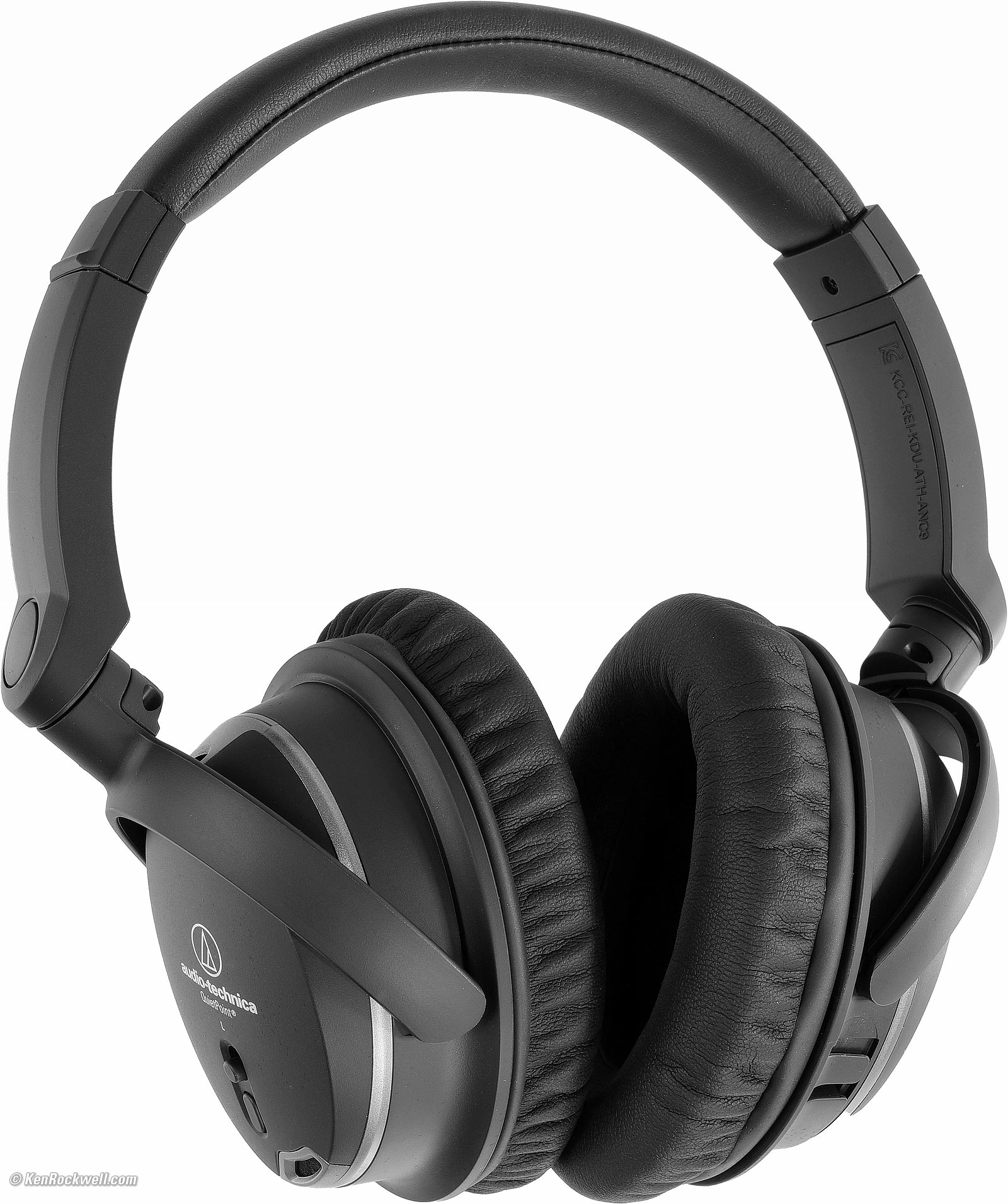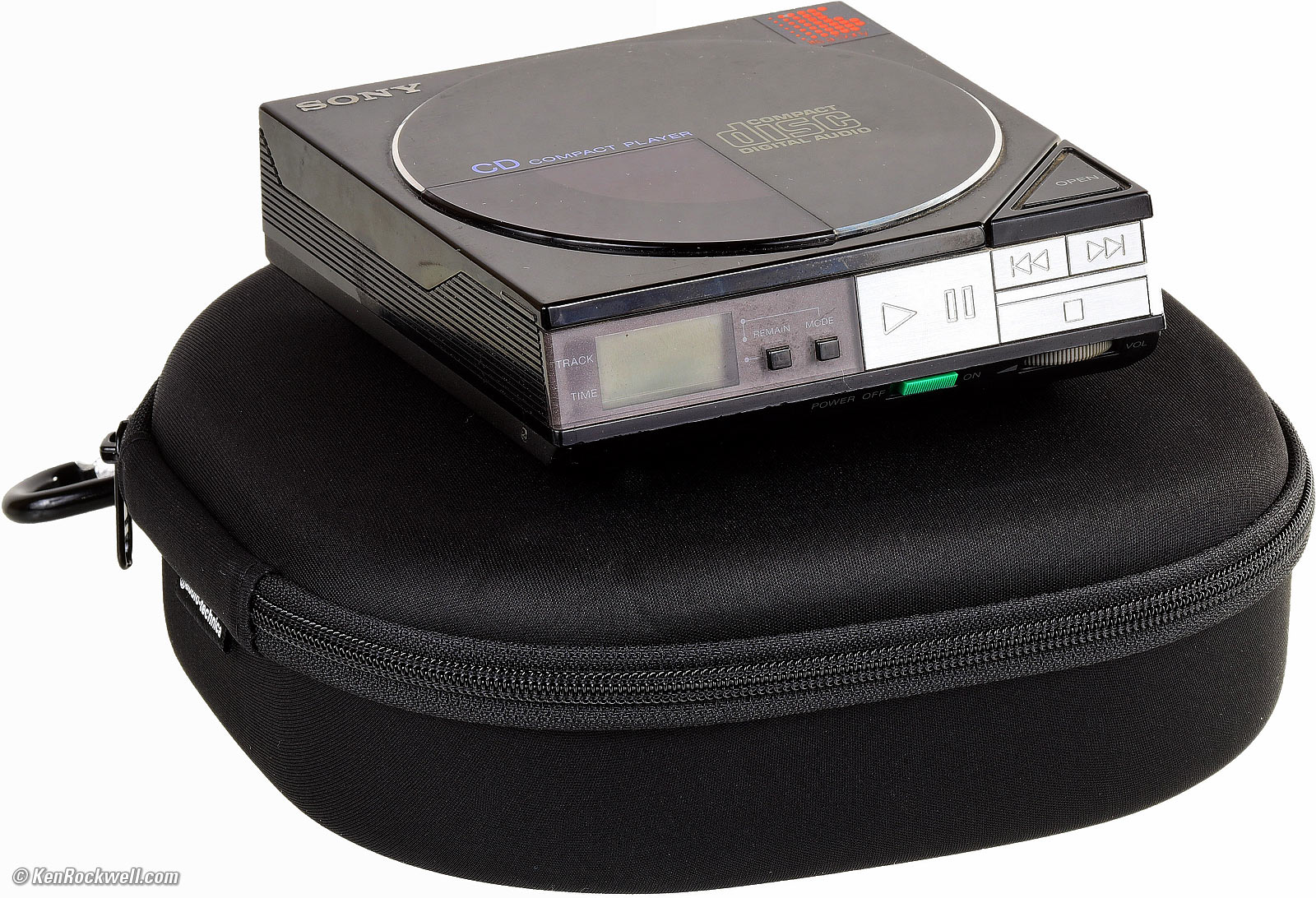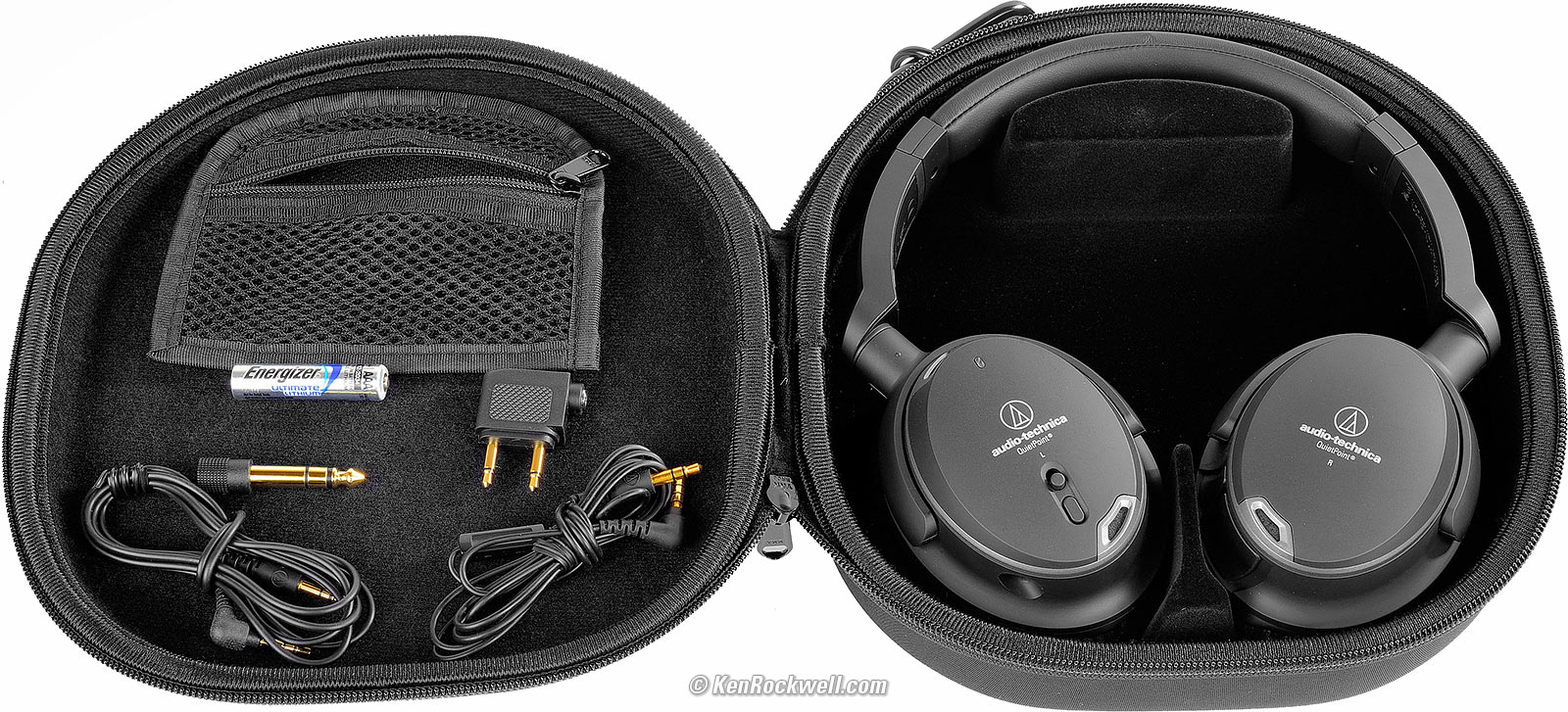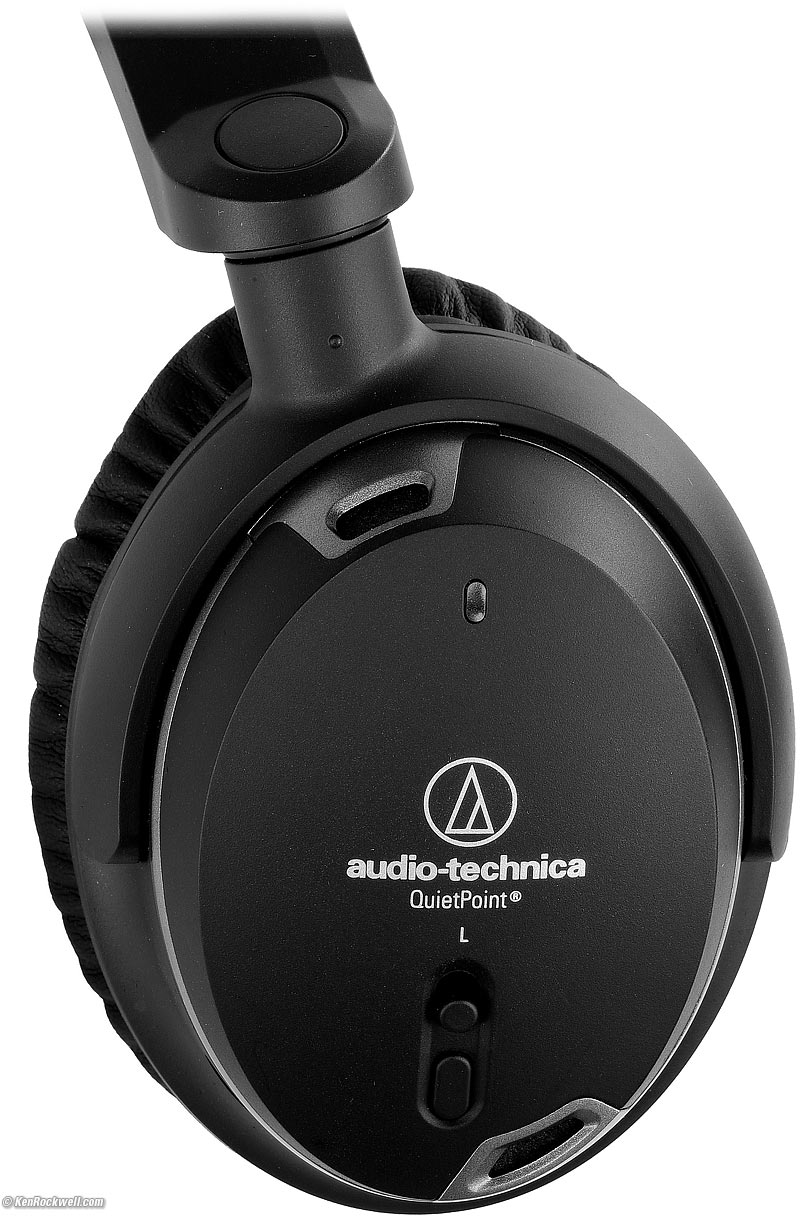ATH-ANC9
Active Noise-Cancelling Headphones
Introduction Technology Specs Performance
Compared Usage Recommendations More
Audio-Technica ATH-ANC9 (takes one AAA cell, 3.5mm remote and plug with ¼" adapter, 8.2 oz./232 g with alkaline cell but no cord, about $200). bigger. I'd get mine at B&H or at Amazon.
This all-content, junk-free website's biggest source of support is when you use those or any of these links to approved sources when you get anything, regardless of the country in which you live. For decades I've used only these approved sources because I get the best prices, best service, best selection and the best return policies. Thanks for helping me help you! Ken.
April 2016 Audio-Technica reviews Bose headphones audio all reviews
Introduction
Top Introduction Technology Specs Performance
Compared Usage Recommendations More
|
Adorama pays top dollar for your used gear. I buy only from these approved sources. I can't vouch for ads below. |
These Audio-Technica ATH-ANC9 headphones reduce noise as well as the top-of-the-line Bose QC-25, but cost only about half as much.
Just like the Bose, they eliminate high-frequency sounds about as much as normal closed, headphones. Also like the Bose, they actively cancel and completely erase low-frequency ambient noise. They eliminate all low-frequency noise and rumble, which is most of what's annoying on an airplane.
These headphones cancel all ambient low-frequency noise and rumble like airplane engine rumble, car interior noise, as well as the noise from heating, air conditioning, hums or rumbles in your home or studio.
Cures Jet Lag
These eliminate jet lag! I wear these the entire time the engines are lit on an airliner, and it saves me from all the noise. Guess what: after my first transcontinental flight without any weariness at the other end I was curious if these could be why, and lo and behold after three transcontinental flights, all with no lag and no tiredness at all, I realized that our bodies do not like being around a lot of noise for long periods. Our bodies interpret noise and rumble as a threat, like a volcano ready to blow or an earthquake, and put our bodies on high alert to address the threat. After hours of this, we're tired. Well, with my ANC-9, I can relax the whole time, and I arrive refreshed and ready to go! I don't waste the rest of the day looking forward to getting to sleep; I have an extra half a day or more of full productivity or vacation.
I arrive refreshed and relaxed. I wear them for the entire flight, even if I'm not listening to anything.
They are therefore a must-have for airline travel. For twice the price the Bose are easier to carry and sound better at home, but if you're like me and don't travel that often, these ATH-ANC9 are a zillion times better to use on a plane than any conventional headphones. These ANC-9 sound just as good as the Bose on the plane; the advantage of the Bose is smaller size and better sound if you also want to use them at home.
When used in the air, they sound fantastic, with clean, smooth, full and detailed sound, as well as without any of the rumble from the jet engines. Enjoying movies on a plane, they have prodigious (strong and deep) bass response.
They're powered from a single AAA cell which is rated to run 25 hours.
If your battery dies or you turn them off, they play and are just as sensitive, but don't cancel noise and sound a little more muffled.
These have big, solid sound swell for music and for movies.
These headphones are best on planes, busses and other noisy areas where they are a huge improvement. They aren't as good for use at home or quiet areas because they have some audible idle noise (hiss), meaning you can "hear the ocean" a little bit if you're in a quiet area and turn them on with no music playing. No worries, just turn them off in a quiet area and they still work — without the idle noise.
They come with a big sturdy case that also holds the various included adapters, cables and a spare AAA cell.
Technology
Top Introduction Technology Specs Performance
Compared Usage Recommendations More
Active noise cancellation means there are two microphones on and in each earpiece that listen to the outside noise, and then subtract (cancel) it from the sound you want to hear. This makes the noise go away. This means the ATH-ANC9 have a built-in headphone amplifier, so you need no other amplifier.
In German, the word for "noise-cancelling" is "Nebengeräuschunterdrückung!"
Specifications
Top Introduction Technology Specs Performance
Compared Usage Recommendations More
Type
Closed-back dynamic circumaural (around-the-ear) headphones with active noise cancellation.
Memory foam headband and replaceable earpads.
Drivers
40mm.
Impedance
100 Ω.
Sensitivity
100 dB.
Frequency Response
10 - 25,000 Hz.
Noise Reduction
Mode 1 (airplane): up to 30 dB.
Mode 2 (office): up to 30 dB.
Mode 3 (study): up to 20 dB.
Plugs & Cords
Two 4' (1.2m) cords included.
One is just a cord, the other has a one-button start-stop remote and mic.
3.5mm plugs on all cables.
3.5mm jack on the headphones; the cables are removable.
Dual 3.5mm airline adapter.
¼" adapter.
Power
One AAA cell.
Rated 25 hours on an alkaline cell.
Rated 35 hours with the included lithium cell.
Rated 20 hours with a rechargeable cell.
Introduced
2012.
Quality
Made in China.
Included
Headphones.
Plain cord.
Cord with remote and mic.
Lithium AAA cell.
Dual-plug airline adapter.
¼" adapter.
Hard case with carabiner.
Audio-Technica ATH-ANC9 included accessories. bigger.
Weight
8.200 oz. (232.5 g) with alkaline AAA cell but no cord, measured.
Rated 7.8 oz (220 g) without cable or battery.
19.280 oz. (546.6 g) in case with all cords and accessories, measured.
Price
$200, April 2016.
$160, March 2016.
$200, Christmas 2015.
Performance
Top Introduction Technology Specs Performance
Compared Usage Recommendations More
Overall
These noise-cancelling headphones get rid of most airplane rumble and run forever on one AAA cell, but are bigger and bulkier than you might prefer for travel. These are great for airplanes, and less well suited for use in quiet places.
Sound
These have excellent rumble reduction, but you can hear a slight hiss if it's quiet enough that you don't need the noise reduction.
The ATH-ANC9 sound smooth and unfatiguing, but they lack the transparency of conventional $300 headphones, and do have audible noise if used with noise reduction in an already quiet environment.
They sound like $40 headphones with $200 worth of noise reduction.
These aren't really for enjoying serious music at home; for less money Audio-Technica's studio headphones like the ATH-M50 sound better if you don't need active noise reduction.
If you really want to enjoy music critically, these aren't intended for it; stick with Audio Technica's studio headphones or splurge on the Bose QC-25.
Bass
Bass is comfortable and round. Most people will like it; it's mildly emphasized but doesn't go that deep.
For normal music and movies it's just right.
Sensitivity
Sensitivity is about the same as other portable headphones, meaning it's got just the right sensitivity for use with iPhones, iPods and iPads with no need for any more amplifiers.
I find I enjoy movies with my iPad volume set to about 1/2, and music with my iPhone volume set to about 5/8.
Isolation & Noise Reduction
In typical Japanese fashion, Audio Technica has to have three different modes, which then means we're always trying the different modes to see which is best.
The three are very similar. There is no change in the sound or the internal noise; all that changes is the amount of noise reduced versus frequency
Mode 1 (airplane) offers the most noise reduction. It completely eliminates all low-frequency noise. It sucks out all the droning, but that can make some people think that their ears are being sucked-out due to the extreme noise reduction when used off an airplane.
Mode 2 (office) is almost the same as Mode 1 (airplane), but has slightly less low-frequency noise reduction. It's just about the same as Mode 1 (airplane), but some new users might find it easier to get used to when used indoors since there's less of a suck-out effect (remember that the reason you're paying for these is precisely because they suck out all the noise).
Mode 3 (study) has the least noise reduction, but it's still very similar to the other modes. It has slightly less isolation and low-frequency noise reduction.
High frequency sounds, like hisses, squeaks and "s" sounds in speech, are only reduced about as much as regular closed headphones. It's the low-frequency drone and rumble which is significantly reduced. Wear these in a car and the engine sound goes away, too, but you'll hear people talking.
People sound thin when they try to talk to you though these, since the low frequencies are cancelled and you're mostly getting the higher frequencies.
Self-Noise
If you turn on noise reduction at home and have nothing playing, you'll hear a slight hiss, like a distant ocean. You won't hear it when the music is playing, since the music hides it.
No worries if it bothers you, turn off the noise reduction and the hiss goes away while the music still plays.
Leakage
These headphones do leak some sound, so they're less useful in quiet places where you're next to other people.
Feel & Ergonomics
They're all plastic.
They feel light.
They stick well to my head while moving around and are comfortable for long periods.
They aren't for walking; they make wobbly sounds while walking or turning my head quickly as if something is shock-mounted and banging around inside. These are for use while seated, not while running.
They stay adjusted; the click stops are sturdy enough so that you don't have to twiddle with them each time you put them on.
They pack in the case while adjusted, too, which is great.
Remote Control & Mic
The remote is only half a remote. It has only one button for start/stop.
There are NO volume control buttons.
On my iPhone 6S Plus with iOS 9.1, it smoothly mutes music on an incoming call. Tap the remote to answer and talk. When you're done, the music restarts automatically where you left off.
Cord
The cords are made of wiggly, slightly grippy jelly-like cable.
They have right-angle plugs to prevent you from breaking them off if hit.
The plugs have enough reach to poke-through thick cases.
Case
Audio-Technica includes a hard zippered case so your nice, soft cushions won't get squashed.
This case is much bigger than other cases.
Here it is under my 1985 Sony D-5, the world's first portable CD player:
Case, Audio-Technica ATH-ANC9. bigger.
This is the biggest drawback to these: they are intended for travel, but do you really want to stuff something this big into your carry on bag?
Here's what's inside:
Case, Audio-Technica ATH-ANC9. bigger.
Power and Battery
I get several trans-continental flights out of each alkaline AAA cell.
When the ANC-9 no longer works, I read about 20% on my ZTS battery ester.
Compared
Top Introduction Technology Specs Performance
Compared Usage Recommendations More
Versus the Bose QC-25
The Bose QC-25 are better at everything, but cost twice as much.
The Bose weigh 7.2 oz. (204g) with one AAA cell, and these weigh 8.2 oz. (232 g).
The Bose have much less idle noise. You'll hear hiss between songs if you use the ATH-ANC9 at home, while you probably won't with the Bose. This makes no difference on a plane.
The Bose have cleaner sound better for enjoying music at home. The Bose also have much better, smoother and deeper bass at home, while these ANC-9 have awesome bass on the plane.
These have a much larger case, but it's much easier to use. You just pop these in and you're done, while with the Bose you have to pull-out the cable and fold them just right to fit them in. These ATH-ANC9 are always ready to go right out of the case, but with the Bose you have to unfold them, plug-in the cable and often resize them to your head again.
The Bose have a volume control on their remote, these don't.
These feel the same on my head.
The important part is that these reduce airplane noise as well as the Bose, which is the whole reason we buy these: peace and quiet while traveling.
Usage
Top Introduction Technology Specs Performance
Compared Usage Recommendations More
Audio-Technica ATH-ANC9. bigger.
Press the little battery door clip and pull out a tray into which to to insert an AAA cell.
It includes an expensive lithium AAA cell. I'd suggest saving this special cell in the case long-term for an emergency, and using your own regular alkaline cells. This is because not only does the lithium cell run about 30% longer than regular alkaline cells, more importantly it's lighter and it lasts for about 20 years if unused!
I kid you not: the expiration date on my included lithium AAA cell is the year 2034! That's my expiration date. If you save the lithium cell instead of using it when you get your headphones, it will always be there if you need it when your other cell wears out.
Slide the round button up to turn these on.
Hold the oval button to swap noise-reduction modes:
Mode 1 (airplane, one beep): up to 30 dB.
Mode 2 (office, two beeps): up to 30 dB.
Mode 3 (study, three beeps): up to 20 dB.
Try these out for yourself; there isn't much difference.
I use Mode 1 (airplane, one beep) for everything. It sucks out the most low-frequency noise.
Mode 2 (office, two beeps) is supposed to suck-out more speech if you're using these around people talking.
Mode 3 (study, three beeps) has less noise reduction to isolate you less from the surroundings.
The good news is regardless of which you prefer, it wakes-up however you left it.
If you're using these someplace quiet and you don't like the self-noise, just turn them off and listen that way.
They have no auto-off function; be sure that they're off (no light showing) when you're done.
Recommendations
Top Introduction Technology Specs Performance
Compared Usage Recommendations More
If you already have good regular headphones and want something with fantastic noise reduction for plane trips, get these since they reduce noise as well as Bose's most expensive model — but cost much less.
In the air, these sound just as good as the Bose.
If you travel all the time or want to use these at home, you'll probably want to pay more for the Bose QC-25 for its smaller case and better sound when used in quiet environments.
If you fly, you need these. Even if you're not listening to anything, take off the cord and wear them for peace and quiet. I wear these walking around the plane since they're so quiet compared to the roar inside the plane.
They also banish ambient noise at home. They let you do what you want in the same room that your wife or kids are watching something else. You can enjoy yours, while they enjoy theirs, and no one bothers anyone.
While these don't replace good conventional headphones for the serious music listener when it's quiet at home, these sound far better than regular headphones when used on a plane since they suck out so much of the noise. You won't appreciate how important this is until you actually try these on a plane in flight; the noise is deafening by comparison when you take these off.
I'd get mine at B&H or at Amazon, both of whom offer money-back guarantees if you don't love these as much as I do.
If you find my work here helpful, this all-content, junk-free website's biggest source of support is when you use any of those links, or any of these links to approved sources when you get anything, regardless of the country in which you live, it helps me keep adding to this free website — but I receive nothing for these efforts if you take the chance of buying elsewhere.
Thanks!
Ken.
More Information
Top Introduction Technology Specs Performance
Compared Usage Recommendations More
Audio-Technica's ATH-ANC9 page.
Audio-Technica's ATH-ANC9 Users' Manual.
© Ken Rockwell. All rights reserved. Tous droits réservés. Alle Rechte vorbehalten.
Help Me Help You
I support my growing family through this website, as crazy as it might seem.
The biggest help is when you use any of these links when you get anything. It costs you nothing, and is this site's, and thus my family's, biggest source of support. eBay is always a gamble, but all the other places always have the best prices and service, which is why I've used them since before this website existed. I recommend them all personally.
If you find this page as helpful as a book you might have had to buy or a workshop you may have had to take, feel free to help me continue helping everyone.
If you've gotten your gear through one of my links or helped otherwise, you're family. It's great people like you who allow me to keep adding to this site full-time. Thanks!
If you haven't helped yet, please do, and consider helping me with a gift of $5.00.
As this page is copyrighted and formally registered, it is unlawful to make copies, especially in the form of printouts for personal use. If you wish to make a printout for personal use, you are granted one-time permission only if you PayPal me $5.00 per printout or part thereof. Thank you!
Thanks for reading!
Mr. & Mrs. Ken Rockwell, Ryan and Katie.







